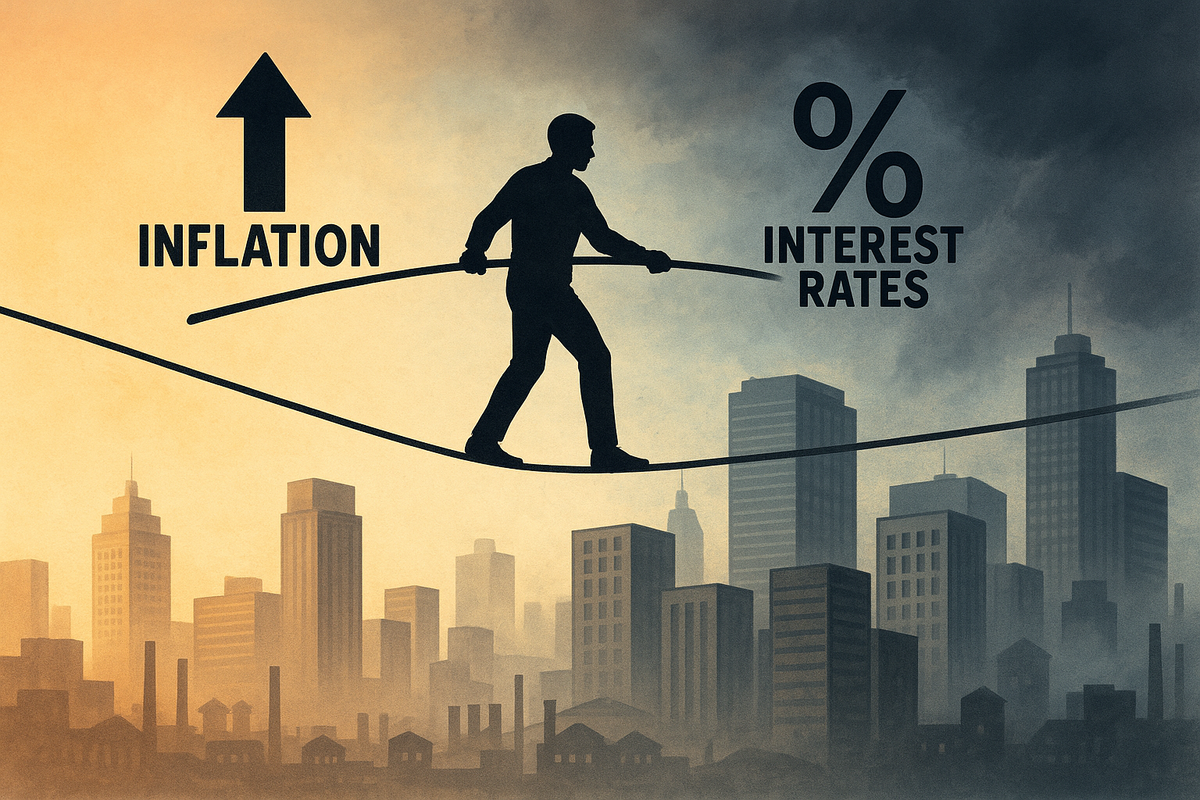
The Federal Reserve finds itself at a critical juncture, navigating a complex economic landscape where the dual mandates of price stability and maximum employment are increasingly at odds. As inflation, though moderating, remains stubbornly above the 2% target, and the labor market shows nascent signs of weakening, the central bank is poised for a delicate balancing act. The coming months are expected to bring a series of anticipated interest rate cuts, yet paradoxically, long-term rates may settle at a higher "neutral" level than previously observed, all against a backdrop of an expected economic slowdown in the latter half of 2025.
This intricate scenario presents significant challenges for policymakers, who must carefully weigh the risks of overtightening and stifling economic growth against the imperative to bring inflation under control. The decisions made in the coming quarters will have profound implications for businesses, consumers, and the broader financial markets, shaping the trajectory of the U.S. economy for years to come.
The Shifting Sands of Monetary Policy: What Happened and Why It Matters
The Federal Reserve's current predicament stems from a confluence of factors, primarily the persistent inflationary pressures that have lingered longer than initially anticipated, coupled with a labor market that, while still robust, is beginning to show cracks. While inflation has receded from its peak, the impact of tariffs and other supply-side constraints continues to exert upward pressure on prices, keeping them above the Fed's comfort zone. Simultaneously, recent data indicates a notable deceleration in job growth, with increasing downside risks to employment, raising concerns about potential layoffs and a rising unemployment rate.
Federal Reserve Chair Jerome Powell has openly acknowledged this evolving dynamic, stating that the "balance of risks appears to be shifting" within the U.S. economy. The Fed's current policy rate is widely considered restrictive, and policymakers are now grappling with the difficult decision of when and how to adjust it to avoid either reigniting inflation or pushing the economy into a deeper downturn. The timeline leading up to this moment has been characterized by aggressive rate hikes to combat soaring inflation, followed by a period of watchful waiting as the effects of these policies permeated the economy. Key players include the Federal Open Market Committee (FOMC), which sets monetary policy, and various economic research institutions whose forecasts heavily influence market expectations. Initial market reactions have been a mix of anticipation for rate cuts and apprehension about the underlying economic weakness that necessitates them.
Navigating the Currents: Potential Winners and Losers
The Federal Reserve's anticipated policy shifts will undoubtedly create a new landscape of winners and losers across various sectors of the economy. Companies with high debt loads, particularly those in capital-intensive industries, could see some relief from lower short-term borrowing costs as interest rates decline. However, the potential for higher long-term rates might temper this benefit, especially for businesses reliant on long-term financing for expansion or large projects.
On the winning side, sectors that are highly sensitive to interest rates, such as housing and automotive, could experience a boost. Lower mortgage rates, even if not returning to pre-pandemic lows, could stimulate demand in the real estate market, benefiting homebuilders like D.R. Horton (NYSE: DHI) and Lennar Corporation (NYSE: LEN). Similarly, reduced financing costs for car loans could encourage consumer spending on vehicles, potentially aiding automakers like General Motors (NYSE: GM) and Ford Motor Company (NYSE: F). Technology companies, often reliant on venture capital and growth funding, might also find a more favorable environment with lower borrowing costs, potentially benefiting firms like Microsoft (NASDAQ: MSFT) and Apple (NASDAQ: AAPL) through increased consumer and business spending.
Conversely, financial institutions, particularly banks, might face headwinds. While lower short-term rates could reduce their funding costs, a flattening yield curve (where the difference between short-term and long-term rates narrows) can compress net interest margins, impacting profitability. Banks like JPMorgan Chase (NYSE: JPM) and Bank of America (NYSE: BAC) could see their lending margins squeezed. Furthermore, companies that have thrived in a high-interest-rate environment, such as those in the short-term lending or money market sectors, might see their competitive advantage diminish. Investors seeking yield might also find it more challenging to achieve attractive returns in a lower-rate environment, potentially shifting their focus towards dividend-paying stocks or other income-generating assets.
Broader Implications: Industry Impact and Wider Significance
The Federal Reserve's delicate balancing act extends far beyond individual companies, carrying significant implications for broader industry trends and the global economy. The anticipated economic weakening in the second half of 2025, driven by inflationary pressures and a slowdown in consumer spending, will likely reverberate across various sectors. Industries heavily reliant on consumer discretionary spending, such as retail and hospitality, could face reduced demand. Companies like Amazon (NASDAQ: AMZN) and Starbucks (NASDAQ: SBUX) might experience slower growth in sales as consumers tighten their belts.
The potential for higher long-term rates, even amidst short-term cuts, suggests a fundamental shift in the cost of capital. This could lead to a re-evaluation of investment strategies across industries, with a greater emphasis on projects with quicker returns and less reliance on long-term, debt-financed expansion. Regulatory bodies will also be closely monitoring the situation, potentially introducing new policies to address financial stability risks arising from persistent budget deficits or shifts in capital flows. Historically, periods of economic slowdown and monetary policy adjustments have often led to increased scrutiny of corporate balance sheets and a greater focus on fiscal prudence. Comparisons can be drawn to previous cycles where the Fed navigated similar challenges, though the current environment is unique due to the lingering effects of the pandemic and geopolitical tensions. The ripple effects could extend to international markets, as a weakening U.S. economy and shifts in interest rates can influence global trade, currency valuations, and capital flows, impacting multinational corporations and emerging markets alike.
What Comes Next: Navigating the Uncharted Waters
Looking ahead, the immediate future will be dominated by the Federal Reserve's actions regarding interest rates. Short-term, the market is pricing in a high probability of rate cuts beginning in September 2025, with further reductions anticipated through the end of the year and into 2026. These cuts are expected to provide some relief to borrowers and potentially stimulate economic activity. However, the long-term outlook is more nuanced, with the possibility of a higher "neutral" interest rate, meaning borrowing costs may not return to the ultra-low levels seen in the past decade.
Companies will need to strategically pivot and adapt to this evolving interest rate environment. Those with strong balance sheets and efficient operations will be better positioned to weather any economic slowdown. Market opportunities may emerge in sectors that are less sensitive to interest rate fluctuations or those that benefit from a shift in consumer behavior during periods of economic uncertainty. For instance, value-oriented companies or those providing essential goods and services might see increased demand. Potential scenarios range from a "soft landing," where inflation is tamed without a severe recession, to a more challenging "hard landing" if the Fed's policies prove too restrictive. Investors should closely monitor inflation data, labor market reports, and the Federal Reserve's communications for clues about the future trajectory of monetary policy and its implications for various asset classes.
Conclusion: A New Era of Economic Prudence
In conclusion, the Federal Reserve's current tightrope walk underscores a pivotal moment in the U.S. economy. The delicate balance between controlling inflation and supporting a potentially weakening labor market will define the economic landscape for the foreseeable future. While anticipated interest rate cuts offer a glimmer of hope for some sectors, the prospect of higher long-term rates signals a potential paradigm shift in the cost of capital, demanding greater financial prudence from businesses and consumers alike.
The key takeaways from this period are the increasing complexity of monetary policy in a post-pandemic world, the persistent influence of supply-side factors on inflation, and the evolving dynamics of the labor market. Moving forward, investors should remain vigilant, paying close attention to economic indicators, corporate earnings reports, and the Federal Reserve's forward guidance. The coming months will undoubtedly test the resilience of the U.S. economy, and the ability of businesses and individuals to adapt to these changing conditions will be paramount to their success. The lasting impact of these policy decisions will likely be a more cautious and perhaps more disciplined approach to economic growth and investment.






